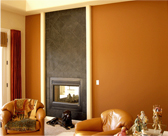 |
Thomas Painting
Dana Point, 92629
|
|
How To Paint Interior WallsHow To Paint Interior Walls There is nothing quite like a new coat of paint to breathe life into the interior of your home. It can be exciting and tempting to jump right in and get started with this seemingly simple paint job. But it is fare better to make a plan as to how to paint interior walls in order to minimize frustration and get it done right the first time around. One of the important things that you will need to do that not many people may consider when painting interior walls is to sand and primer them. When you sand the wall first it allows the paint to be applied more evenly as well as helping it stick to the surface better. Also, by using a primer before you paint the final coats, you can reduce the amount of paint you will use, and therefore the time it takes to do it. Generally using a primer is especially important when you are switching from light to dark colors, or vice versa, but really a primer is not a bad idea in any situation. The typical train of thought for most people who are just beginning to paint interior walls is that you need to tape up all the surfaces you don't want to accidentally drip paint on. While it is not a bad idea, in many cases it is very time-consuming and not really necessary. In fact using the wrong tape on the wrong surfaces can lead to problems of its own. It is oftentimes better to purchase an angled brush and just take your time when applying the paint. It is also good practice to move all the furniture in the room to center, away from the walls. Of course it should almost go without saying that you must also remove any decorative items from the wall. It is vital to protect the floors with some sort of tarp or drop cloth. Many might choose plastic for this purpose because it can be cheaper. However, plastic can be slippery and in the event of a spill canvas will absorb more liquid rather than letting it run all over. Don't overlook the electrical outlet covers either. They need to be unscrewed, pulled out from the wall, and covered with tape that is specifically made for this purpose. If you plan on painting the ceiling at the same time you will want to start there. You should always work from the top down, sanding and painting the ceiling before moving on to painting the walls, and finally finishing with the baseboards if you are painting those as well. After you have sanded the walls, you should plan on filling in any holes or gouges with putty. Finally, you are ready to start painting! Paint a strip around the edges, corners, molding and windows. This method is often called "cutting in" and will make it easier when it comes time to paint the rest of the walls with a roller. When using a roller to paint the walls, just roll using one smooth stroke. Do not get overly worried about having the first coat of paint look perfect. Also important is to not roll back and forth over the same area multiple times. Simply move on to the next area and keep rolling. Minor inconsistencies in paint application will be evened out as you apply multiple coats. |
    |
|
Home |
Services |
Testimonials |
Helpful Info |
Contact |
Terms |
Privacy Policy
License #386182, Bonded & Insured ThomasPaintingOC.com. Copyright © 2011. All Rights Reserved. |
 |
